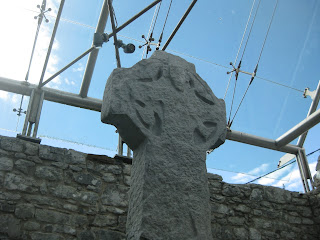After leaving the cliffs we headed to Kilfenora where the Burren Center was located. We had plans on doing a hike in the Burren the next day and wanted to see what the options were. Along the way we passed another of these block tower castles. Built in the 14th and 15th centuries to protect wealthy chieftains they are located thru out Ireland. Some have actually been restored and are used as guest houses. We learned that inside the stair case went up counterclockwise around the outside walls so that the defenders when coming down from the top floors would have the advantage with their swords free.
 We got to Kilfenora late in the afternoon, and after visiting the Burren Visitor Center, decided that we would not do any of their hikes. Next door to the center is the Kilfenora Cathedral. Our guidebook said that the church next door to the Visitor Center had a couple of crosses but wasn't much to see,
We got to Kilfenora late in the afternoon, and after visiting the Burren Visitor Center, decided that we would not do any of their hikes. Next door to the center is the Kilfenora Cathedral. Our guidebook said that the church next door to the Visitor Center had a couple of crosses but wasn't much to see,but looking over I saw the the church had what looked like a plexiglass roof over one section, so we ambled over and had to walk over some gravestone to find the entrance.
We found that a lot of work had been done inside the cathedral and that a new exhibit had been just completed inside with lot's of graphics and descriptions. We found that originally their was a monastery built here around 540 AD and later around 1189 the Cathedral had been built. The glass roof has been added to help preserve the interior and to cover the crosses. Of the seven high crosses that were originally in the area 3 remain well intact. They were carved out of limestone about the same time that the Cathedral was built and are quite ornate. The crosses had been located outside on the intersections of the roads leading into Kilfenora. The Doorty cross above has a bishop with a staff
The cross above is the North Cross with ornate carvings and below one of the windows with a Bishop's head. It was all quite impressive and we were glad we had discovered it.

















































